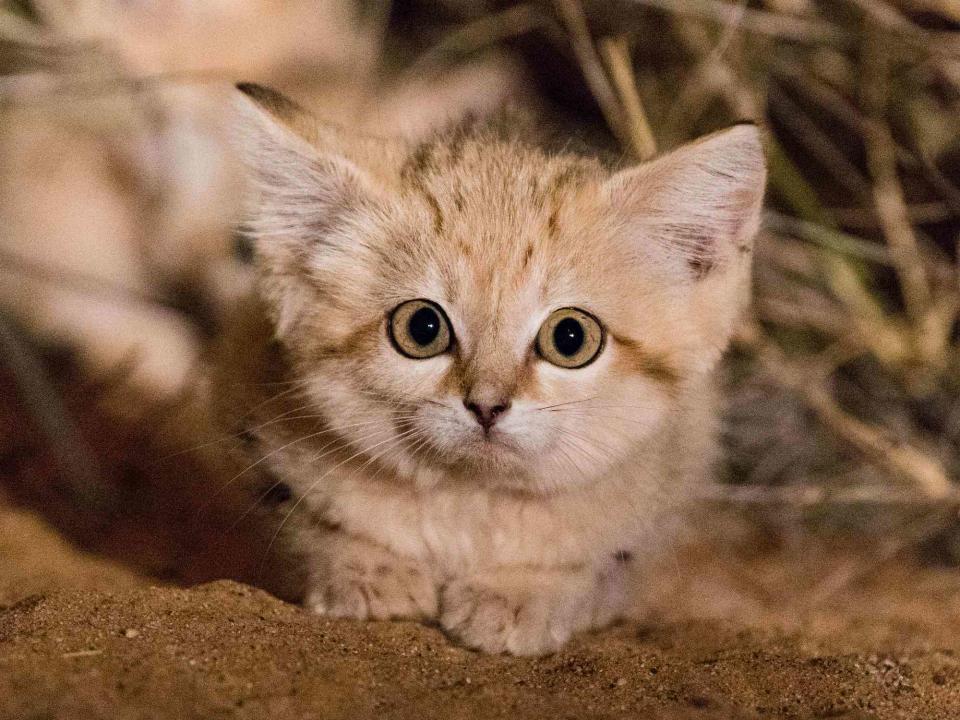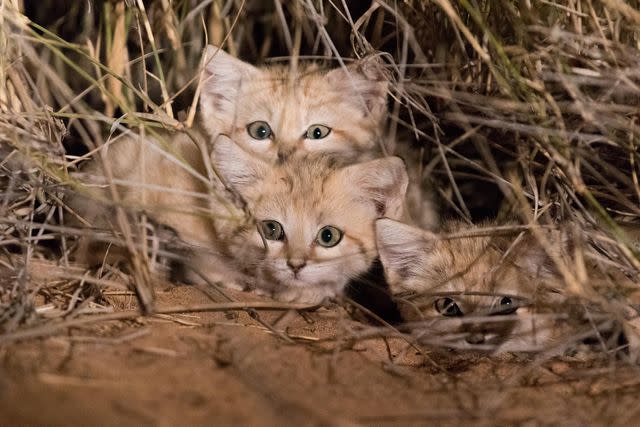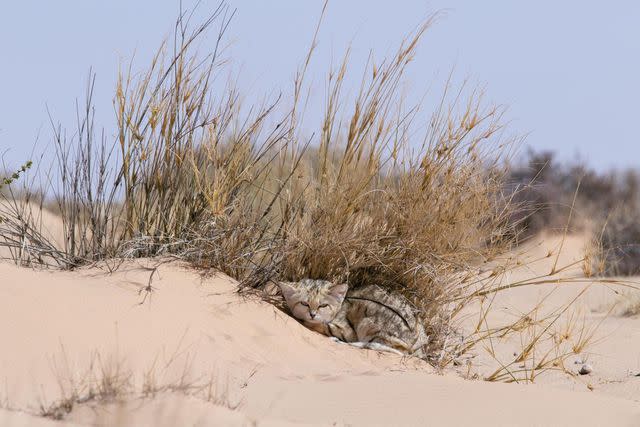Morocco’s Tiny Sand Cats Reveal Behavior Never Before Seen in Wild Cats
Researchers tracking the charismatic carnivores say their findings are ‘truly eye-opening’ and may warrant an upgrade in conservation status.

Gregory Breton
One of the first images of a sand cat kitten ever documented in the wild in Morocco by Panthera and partners, 2017Sand cats rocketed to fame in 2017 when photos of the wee wild cats from a study conducted by Grégory Breton, managing director of Panthera France, took the Internet by storm. Weighing up to just 7.5 pounds, members of this admittedly adorable species look not too different from a small housecat. Except that these are wild cats uniquely adapted to some of the planet’s harshest conditions. Native to Africa's Sahara Desert and the Arabian Peninsula, Felis margarita is the only feline to live exclusively in deserts.
Now the Panthera team is back with a new study, marking the most extensive research on the ecology of this species in the wild. The study, which appears in the Journal of Arid Environments, provides the largest dataset on the home range of sand cats ever recorded.
The findings from the years-long study, which Panthera conducted with scientists from the Rabat and Cologne Zoos, add important new information to the understanding of this little-known species. As well, the scientists suggest that an upgrade in conservation status to ‘Near Threatened’ may be warranted.

Gregory Breton
“What we found is truly eye-opening, and we hope that our research will assist in guiding this species’ conservation,” writes Breton on Panthera.
After tracking 22 sand cats with VHF radio collars and intermittently following and observing them in southern Morocco between December 2015 and December 2019, they discovered that sand cat ranges are much more extensive than previously thought.
“Incredibly, they rival ranges of much larger cats like leopards and tigers, with one sand cat covering an area of up to 1,758 square kilometers (about 1,093 square miles) over 6.5 months,” explains Panthera. The researchers now believe that sand cats probably maintain the largest range of cats of their Felis genus, including black-footed cats and African wildcats.
Because the desert conditions were so extreme and the equipment somewhat limited—and the cats so elusive—the researchers had no shortage of challenges. But while the desert may seem harsh and desolate, Breton describes it as rich with life:
“Our journey began in a scorching desert, with temperatures that can soar up to 50 degrees Celsius (122 degrees Fahrenheit) during the summer months. Local herders flock by with goats or camels, often accompanied by guard dogs. Though the flat, arid land may sometimes look bleak and barren, it is alive with incredible wildlife including poisonous snakes, golden eagles, African golden wolves and African wildcats.”

Gregory Breton
The landscape of the Saharan Desert. Morocco, 2019Of the 22 cats they tracked over the years, they were able to collect strong data for 10 of them. “We even managed to track one cat for over a year: a male that ventured far and wide. It is this behavior which we found so eye-opening; we discovered that sand cat home ranges are likely considerably larger than previously estimated,” says Breton.
The study’s findings suggest that these charismatic carnivores may not rely on defined home ranges, but rather, maintain a somewhat nomadic lifestyle, moving from one location to another based on influences like rainfall fluctuations. “If true, this type of movement in response to rainfall is previously unrecorded among wild cat species,” says Panthera.
Another interesting point from the study possibly hints at social dynamics. The authors note that all the sand cats they observed in the area, along with the ones they tagged, were in good external condition, showing no wounds, very few scars, and no broken teeth. From the study: “We hypothesize that the sand cats are tolerant of each other and likely non-territorial. Our understanding of their ecology remains however limited and their social organization and mating pattern almost unknown.”

Gregory Breton
A female sand cat rests under a bush, seeking refuge from the Saharan sun, 2018While the presence of sand cats has been documented in 24 countries, from North Africa across the Middle East to southwest and central Asia, they have not been reported in four of the countries since 2000. With the findings from the new research, the authors note that the discovery of such large ranges for this cat has important conservation implications.
In the study, the authors explain that between 2008 and 2016, the sand cat was classified as Near Threatened by the International Union for the Conservation of Nature (IUCN) Red List. However, it was upgraded to Least Concerned due to revised IUCN Red List Assessment instructions and based on previously small home-range size estimates. “But if the species home ranges are significantly larger as our study tends to demonstrate, population numbers could be lower than estimated,” write the authors.
As Breton summarizes, “If the home ranges are indeed larger and they are only occupying certain parts of the desert as our study suggests, they could reasonably be upgraded to Near Threatened—causing us to redouble our conservation efforts.”

Gregory Breton
“There is still so much to learn about sand cats. With the future comes more opportunity to understand their home range sizes and the new territory we still leave unexplored,” adds Breton. “For now, I will keep sharing videos and pictures of this charismatic cat. For the sake of their conservation, they need it.”

